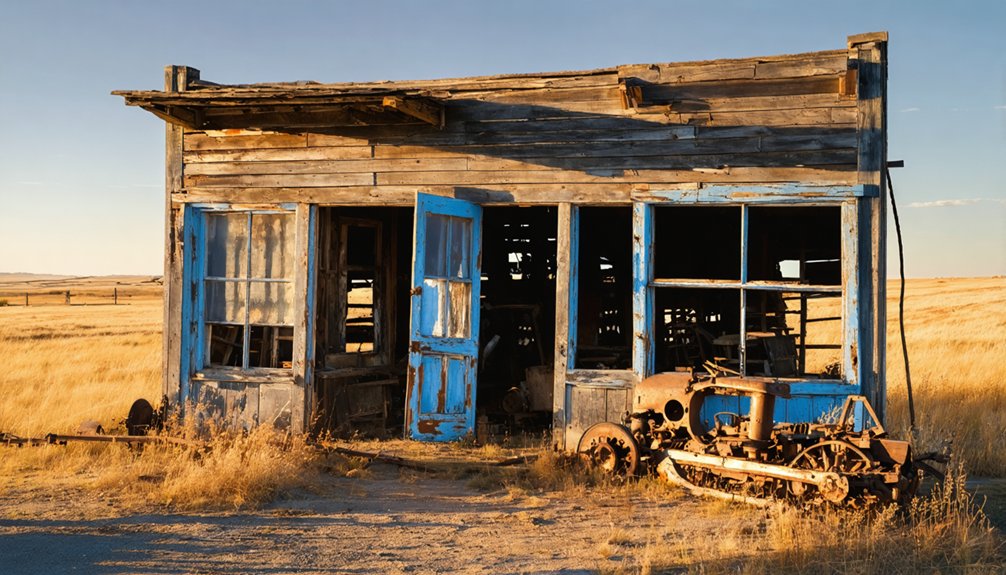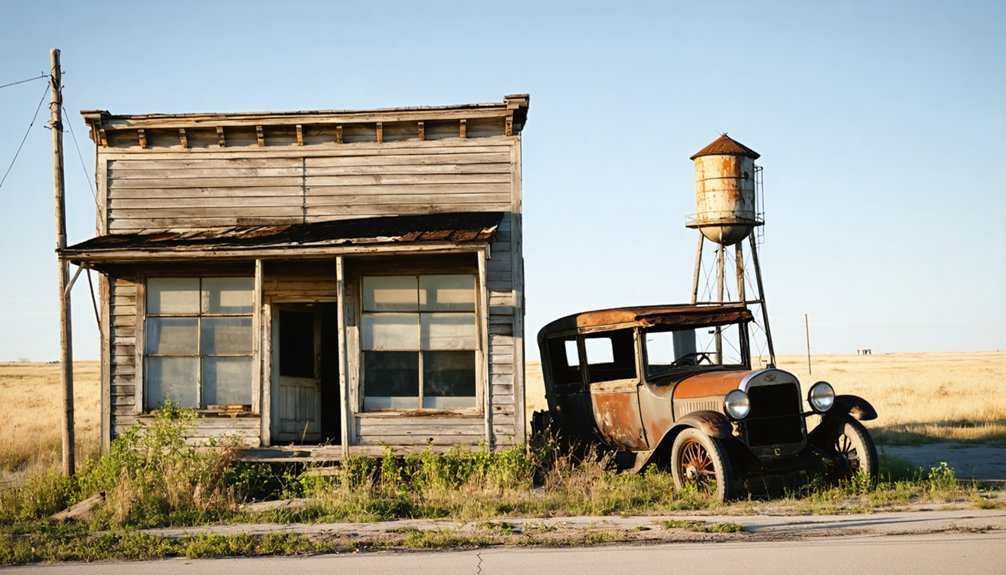You’ll discover Fountain City as one of the original seven mining camps that sprang up in South Dakota’s Deadwood Gulch during the 1876 Black Hills gold rush. The settlement attracted diverse miners and laborers, including white, Black, and Chinese workers who endured sixteen-hour workdays. While Fountain City eventually merged into what became historic Deadwood, its legacy lives on through tourism and reenactments that capture the wild spirit of the Black Hills mining era. The story of this pioneering settlement holds many more fascinating details.
Key Takeaways
- Fountain City emerged as one of seven mining camps in Deadwood Gulch during the 1874 Black Hills gold rush.
- The settlement eventually merged into Deadwood’s expanding footprint, losing its independent identity.
- The town featured several hundred residents, churches, community halls, and a newspaper during its peak mining days.
- Much of the original Fountain City site now lies submerged beneath Lake Oahe’s waters.
- The area’s mining operations evolved from simple placer mining to complex underground operations using cyanide processing.
The Rise of a Black Hills Mining Settlement
While the famous Custer Expedition of 1874 first confirmed gold in the Black Hills near present-day Custer, South Dakota, it wasn’t until 1876 that Fountain City emerged as one of seven mining camps dotting Deadwood Gulch.
You’d have found a bustling scene of fortune-seekers defying the 1868 Fort Laramie Treaty, which had reserved these lands for the Sioux people. Gold fever drove a transient population of miners, merchants, and speculators to construct makeshift buildings and primitive roads along the creek. The arrival of Wild Bill Hickok that summer brought additional notoriety to the growing settlement.
Like its neighboring camps, Fountain City attracted a diverse mix of white, Black, and Chinese laborers seeking quick wealth through placer mining. The settlement’s early success relied on easily accessible surface gold deposits, which miners extracted using basic tools like pans and sluices. The nearby Homestake Mine would later become one of the region’s most profitable operations, producing $720 million in gold over the next century.
Life During the Gold Rush Era
As miners flocked to Fountain City in 1876, they faced grueling sixteen-hour workdays that began with basic placer mining along creek beds and eventually shifted to more demanding hard rock extraction.
The evolution of mining technology brought innovations like the Jones and Pinney Mill, where stamp mills crushed ore and mercury amalgamation separated precious gold. The discovery of gold during Custer’s 1874 expedition had set off this chain of technological advancement. The Homestake Mine became the region’s dominant producer, yielding an impressive tenth of global gold supply.
Life in this bustling Black Hills settlement showcased remarkable community resilience:
- You’d find a mix of tents and wooden structures housing determined prospectors, with saloons and general stores serving as gathering spots.
- You’d work alongside miners from diverse backgrounds, all sharing the dream of striking it rich.
- You’d battle harsh conditions underground, from toxic mercury exposure to poor ventilation.
- You’d experience the boom-and-bust cycles that defined the era, where fortunes could change overnight.
Geographic Features and Natural Surroundings
Nestled within the rugged Black Hills region of South Dakota, Fountain City’s natural setting played a crucial role in its brief but vibrant history. A topographic analysis reveals the town’s strategic location near natural springs and creeks, with elevations ranging from 3,000 to 5,000 feet above sea level.
You’ll find remarkable ecological diversity throughout the area, from ponderosa pine forests to mixed-grass prairie. The town’s namesake springs once provided essential water resources, while the surrounding landscape supported abundant wildlife including deer and coyotes. The area contains crumbling foundations and scattered debris from the original settlement.
Today, much of the original site lies beneath Lake Oahe‘s waters, but the region’s characteristic features remain – rolling hills, rocky outcrops, and seasonal streams typical of the Black Hills. Like the historic towns of Sheridan and Pactola, Fountain City’s remnants now rest underwater.
Despite harsh winters and semi-arid conditions averaging 15-20 inches of annual precipitation, the natural environment sustained this frontier community during its heyday.
Mining Operations and Economic Activities
The discovery of gold in the Black Hills during the mid-1870s transformed Fountain City from a pristine wilderness into a bustling mining hub.
Gold’s discovery in the Black Hills sparked radical change, turning Fountain City’s untouched landscape into a thriving mining settlement.
As prospectors flooded the area, mining techniques evolved from simple placer mining to sophisticated underground operations. The Sioux Nation treaty had originally protected these lands from mining activities.
You’ll find that Fountain City’s story mirrors the broader Black Hills Gold Rush, though it was overshadowed by the nearby Homestake Mine. The discovery at Spring Creek and Crook City drew thousands of fortune seekers to the region.
- Early miners used basic placer mining in creek beds, extracting visible gold
- The introduction of cyanide processing in the 1890s revolutionized gold recovery rates
- Labor dynamics shifted as operations grew, requiring more skilled workers
- By the early 1900s, mechanization and deep mining techniques replaced earlier methods
Unfortunately, Fountain City’s prosperity was short-lived.
When the easily accessible gold ran out and costs rose, the town’s mining operations couldn’t compete with larger operations, leading to its eventual abandonment.
Daily Life and Social Dynamics
While mining operations formed the economic backbone of Fountain City, daily life revolved around a close-knit community of several hundred residents who created a vibrant social tapestry.
You’d find the heart of social cohesion in the local churches, community halls, and bustling businesses like the general store and café. Community events brought everyone together regularly – from theatrical performances and rodeos to town hall meetings and sports games. Like many towns established in South Dakota, Fountain City was strategically placed seven miles apart from neighboring communities.
The local newspaper kept you informed while strengthening bonds between neighbors. Like the Owanka Bee Newspaper, the town’s media served as a vital communication hub. When winter’s harsh grip took hold, you’d gather in the community hall for dances and celebrations.
Local business owners often stepped up as community leaders, and social clubs provided regular opportunities for recreation and connection until the town’s eventual decline.
Merging With Historic Deadwood
During spring 1876, Fountain City emerged alongside six other mining camps scattered throughout Deadwood Gulch, setting the stage for a transformative merger. By February 1881, these camps officially united to form the municipality of Deadwood, forever changing the region’s destiny.
The cultural integration of Fountain City into Deadwood brought significant changes:
- The merger centralized economic activities, from mining operations to hardware stores like Star and Bullock.
- Law enforcement improved under Sheriff Seth Bullock’s leadership across the unified territory.
- Infrastructure expanded with the Black Hills Water & Canal Company serving the entire population.
- Entertainment venues and gambling houses flourished throughout the combined settlements.
You’ll find Fountain City’s historical significance preserved in modern-day Deadwood, where tourism celebrates the wild spirit of these merged mining camps through reenactments and historic sites.
Legacy in South Dakota’s Mining History

As Fountain City merged into Deadwood’s expanding footprint, its pioneering spirit left an indelible mark on South Dakota’s mining legacy.
You’ll find its story intertwined with the region’s dramatic economic fluctuations, from the initial 1876 gold rush fever to the shift toward industrialized mining operations.
While Fountain City started as one of seven original Black Hills mining camps, the area’s true technological revolution came with the introduction of cyanide processing.
By 1928, the Bald Mountain Mining Company had revolutionized mining technology, achieving remarkable 94% recovery rates from complex ores that early prospectors couldn’t effectively process.
Though smaller operations like Fountain City eventually gave way to giants like the Homestake Mine, they’d helped establish the Black Hills as a premier mining district, shaping South Dakota’s economic landscape for generations.
Frequently Asked Questions
Were Any Significant Gold Nuggets or Treasure Finds Documented in Fountain City?
Like searching for a needle in a haystack, you won’t find records of major gold nuggets in Fountain City. While treasure hunters sought riches there, documented gold discoveries occurred in neighboring areas.
Did Any Famous Outlaws or Wild West Figures Visit Fountain City?
You won’t find documented outlaw encounters or wild west legends in this town. Historical records show no evidence that famous outlaws visited, as they typically frequented larger, better-documented settlements like Deadwood.
What Indigenous Tribes Originally Inhabited the Fountain City Area?
You’d find the Dakota Nation, particularly the Mdewakanton, Wahpeton, Wahpekute, and Sisseton bands, dominated the Fountain City area, while Lakota and Cheyenne tribes roamed nearby regions before European settlement.
Were There Any Recorded Supernatural Occurrences or Ghost Stories From Fountain City?
You won’t find documented accounts of ghostly apparitions or haunted locations from Fountain City. Historical records don’t mention any supernatural occurrences, and no verified ghost stories have emerged from this abandoned settlement.
Did Fountain City Have Its Own Newspaper or Post Office?
You won’t find records of a Fountain City newspaper or post office in historical documents. Available archives and government records don’t show evidence that either service existed in this location.
References
- https://www.sdpb.org/rural-life-and-history/2023-08-21/some-black-hills-ghost-towns-and-their-origins
- https://www.powderhouselodge.com/black-hills-attractions/fun-attractions/ghost-towns-of-western-south-dakota/
- https://www.sdhspress.com/journal/south-dakota-history-2-2/some-black-hills-ghost-towns-and-their-origins/vol-02-no-2-some-black-hills-ghost-towns-and-their-origins.pdf
- https://www.youtube.com/watch?v=_0WNYsFLSLA
- https://core.ac.uk/download/pdf/345016075.pdf
- https://www.legendsofamerica.com/crystal-city-north-dakota/
- https://www.blackhillsbadlands.com/blog/post/old-west-legends-mines-ghost-towns-route-reimagined/
- https://en.wikipedia.org/wiki/List_of_ghost_towns_in_South_Dakota
- https://icatchshadows.com/okaton-and-cottonwood-a-photographic-visit-to-two-south-dakota-ghost-towns/
- https://blackhillsvisitor.com/learn/spokane/



